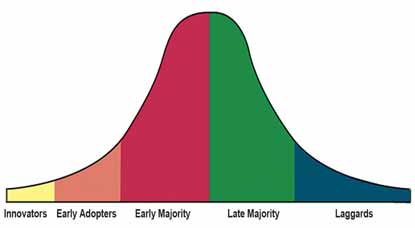Here Comes the Sun: Marketing Your Premium Practice
Summarizing the last 24 months in song would be quite the contest. BJ Thomas’ “Raindrops Keep Falling on My Head” would be vying for a spot with Pink Floyd’s “The Wall” as the most appropriate song for the industry’s economic blues. Beck’s “Loser” would easily win out over a similarly titled anthem from the Beatles (“I’m a Loser”). Certainly, the last 24 months have been challenging for the refractive surgery industry. Some folks are still apprehensive about “getting back in the game,” in terms of creating demand through new or traditional marketing tactics. Many others have decided that George Harrison was right: now is the time to plan for sunnier days.
Major Marketing Decisions: The Four Ps
In the years leading to the downturn, major marketing decisions in premium practices typically fell into one of the following four categories known as the Four Ps of Marketing: product, price, place (distribution), and promotion. These variables were altered to best satisfy the practice’s customers in the desired target market. In most cases, and in the field of refractive surgery generally, emphasis was placed on these four categories to encourage a prospective patient to inquire about a practice’s offerings. As you read these definitions, pay special attention not only to their descriptions but also to the typical cataract and refractive practice’s handling of each marketing component.
| Category | Description | Old Marketing Approach |
|---|---|---|
| Product | The product is the actual offering or service made to the patient/customer. In the case of physical products, it also refers to any services or conveniences that are part of the offering. Product decisions include aspects such as function, appearance, packaging, service, warranty, etc. | The surgery is the product. |
| Price | Pricing decisions should take into account profit margins and the competitive landscape. In the world of marketing, pricing includes not only the list price but also discounts, financing, and other options such as leasing. | Prices are lowered to increase demand. |
| Placement | Decisions regarding placement are those associated with channels of distribution that serve as the means for getting the product to the target customers. | Placement is classically regarded as “media outlets.” |
| Promotion | Promotional decisions are those related to communicating with and selling to potential consumers. Since these costs can be large in proportion to the product’s price, a break-even analysis should be performed when making promotional decisions. It is useful to know the value of a customer in order to determine whether additional customers are worth the cost of acquiring them. Promotional decisions involve advertising, public relations, media types, etc. | Promotion looks like refractive surgery sales. |
The Industry
From an industry standpoint, laser vision correction volumes have been steadily decreasing as society has moved from the early-adopters stage of a product’s or service’s life cycle to the early-adopters/early-majority/middle-majority stage. Today, more than ever, patients (customers) are concerned about safety, value, and long-term stability. According to Market Scope’s quarterly survey of refractive surgeons, U.S. laser vision correction procedures declined 26.6% in 2009 when compared to 2008 [D. Harmon, personal communication, April 2010]. Although this shortfall has been met with consistent growth in the areas of IOLs and therapeutics (particularly in cataract surgery), offsetting the loss of total procedural volume and the resulting loss in net revenue will be a major challenge for refractive surgery centers in the years ahead.

The technology adoption life cycle
Moreover, an operational risk exists if this mix of growth in implants and therapeutics continues alongside decreasing volumes in laser vision correction. Basically, similar procedural volumes could result in far lower net revenue with which to run your practice unless a “refractive-style” model can be adopted in the therapeutic category.
Supplementary and Replacement Revenues
Marketing’s function is to assess the pros and cons of potential offerings and determine their ability to add value to the core mission of the vision correction industry. I mention this because the future vitality of refractive surgery lies in the industry’s ability to focus on its mission of improving vision across constituencies.Innovation rules. Practices cannot become distracted by offering other “replacement” revenues as their core business. Everything a premium practice offers must revolve around or be supplementary to the core function of correcting vision. Otherwise, a meaningful system of distribution no longer exists.
Within the confines of the mission I describe, new sources of revenue do exist. Nutritional supplements, aesthetic services, myopic treatments (not procedures),and new options for presbyopic correction can bolster the practice’s bottom line without disrupting the mission. Be mindful, however, of how consumers perceive your practice’s role in vision care and make every effort to hold that spot in their minds.
Mass Communication Is for Mass Production
Descriptions of where products or services are in their technology-adoption lifecycle are relics of goods-based economies. Goods-based economies performed best during the industrial era when phrases such as “product lifecycle” were used to describe consumers‘ purchasing tendencies across a uniform and lateral product line. Each product was made to be as identical as possible and kept as inventory until the time of purchase. Firms were more successful when they could mass produce uniform products. Customers were relatively satisfied because they had access to more offerings than ever before. The fact that an item was not exactly what the customer desired was superseded by the value and number of options available to them in the economy based on mass production.
“The concept of mass production is problematic in an economy that is now defined by customers’ experiences.”
The concept of mass production is problematic in an economy that is now defined by customers’ experiences and even more so in an environment of elective medical health care, where the push is to increase offerings to offset decreased volumes. As Joseph Pine III and James Gilmore state in their groundbreaking book The Experience Economy: Work Is Theater & Every Business a Stage, in elective health care, the intended aim is not mass production but mass customization, a strategy of uniquely serving each customer in an efficient way.1
Today, the elective health care industry is offering a transformational experience under the mass production model. I believe this is driving prices into the ground, expectations through the roof, and centers to their knees. Why? There is no reference, framework, or architecture to build from to make the experience of laser vision correction truly experiential in the mind of the customer. Even more difficult than staging a customer’s experience that is worth the price of admission is doing so in a consistent and efficient manner. I fear that our industry, manufacturers included, is still unsure of what truly motivates patients, resulting in the development of self-serving messages designed to increase marketshare, not grow the whole.
This is described by Pine and Gilmore:
We see many companies today floundering in how to market their offerings thanks to the demise of mass markets, the ineffectiveness (and unmeasurability) of advertising, and the seeming failure of using the WorldWide Web as an effective marketing vehicle. That’s why we also see a plethora of “adjective-based” marketing ideas; to name just a few, think of guerilla marketing, permission marketing, viral marketing, even emotion marketing and emotional marketing. Each type may have something valuable to say, but never really addresses the heart of the problem: People have become relatively immune to messages targeted at them. The way to reach your customers is to create an experience within them.2
Marketing Operations
Perhaps more important than your actual marketing message is the support you give it through marketing operations. The best advertisement can only make alogical prospect try your product or service once. If that consumer’s experience does not measure up to his or her expectations, the failure lies in the operations, not the advertisement. Special attention must be paid to the operational side of the practice to ensure that the experience is worth whatever was invested in the advertising budget.
Shareef Mahdavi, the president of SM2 Strategic in Pleasanton, California, said it best in a recent posting on the Premium Experience Network:
Unlike the traditional marketing or advertising budget, investing in the customer experience doesn’t require huge budgets…but does have two specific needs: your mind and your time. In fact, as the leader of your practice, it’s critical that you adopt a mindset of making the customer and their experience the key differentiator of your practice compared to other doctors of the same specialty in your area. Experience has shown that any attempts to improve the levels of service will generally fail if the physician is not wholeheartedly committed to the cause.
Time, not money, is the primary resource you will spend on the path to being world class in the eyes of your customer. With advertising, it’s the opposite. You spend significant amounts of money to generate awareness and interest in your practice and its services.But once that money is spent, it’s gone. With service, you will invest significant amounts of your time in your staff. But what you are building is a process to identify and address “service defects” and to enhance the overall experience. You are simultaneously building a culture among your staff that says “here is what’s important to our practice.” Realistically, you will spend money on training sessions, systems/hardware/software, and cosmetic improvements. But those investments are long lasting and do something advertising cannot: fulfill the hopes, desires and expectations of your customers above their role as your patients.3
In assessing your practice’s marketing operations, consider these questions:
- Do you devote specific staff meetings (or separate sessions) to the topic of customer service?
- Who is in charge of customer service in your practice?
- How much are you spending each quarter on advertising/promotion versus improving levels of service?
Reserve time and energy to create your practice’s internal processes and structure, not just its external campaign. However, once the operations are in order, how should a practice go about creating its initial messages?
Creative Brief
The first and perhaps most important piece of your advertising communications is flagging your prospect.The best approach is to pay attention to the creative work plan, otherwise known as the creative brief in marketing circles. This document boils down the important details of an advertising message to be certain the message achieves the desired outcome. A creative brief is created by following these steps:
1. Why are you advertising?
It is critical to determine why the advertisement is being created. Otherwise, there is a tendency to throw everything but the kitchen sink into the message. If there are two reasons for creating the advertisement, develop two ads. Some reasons for an advertisement are:
- The practice has a new technology that is safer and more accurate than a more traditional technology.
- A new doctor is being added to the practice.
- The practice has a new offering or is adding a new location.
2. To whom are you talking?
Here is where you define your target audience. For example, a practice might decide that its prime market for laser vision correction includes individuals aged 35 to 54 years, with 60% being women. Potential customers would be defined as those who would like to reduce their dependence on glasses or contact lenses but have not yet done so due to concerns about safety.
3. What do you want customers to think, feel, or do as a result of the advertisement?
Perhaps you want patients to understand how important laser vision correction can be to their quality of life. Maybe you want to appeal to their desire for spectacle independence during activities. Perhaps you simply want to position your center as the authority in vision correction. Here, this is all hashed out. However, keep in mind, the most effective use of your message is to communicate only one thing.
4. What one thing makes this offering different or better?
What is unique about this offering? Before youcommunicate with your prospective patients, be sure that you understand what the business world calls your unique selling proposition. This is what sets you apart from competitors in your category. It may be experience, technology, safety, accuracy, or exclusivity. Resist sales offerings here as they typically are not unique. The same promotion you run can be run by your competitor next week. Stick to what is unique.
5. The New Four Ps
After establishing the reasons for communicating and how these will increase reliance upon the practice’s marketing operations, the four Ps of marketing can be rearticulated in a way that instills a more customer-centric experience.
| Category | Description | New Marketing Approach |
|---|---|---|
| Product | The product is the actual offering or service made to the patient/customer. In the case of physical products, it also refers to any services or conveniences that are part of the offering. Product decisions include aspects such as function, appearance, packaging, service, warranty, etc. | The patient is the product. |
| Price | Pricing decisions should take into account profit margins and the competitive landscape. In the world of marketing, pricing includes not only the list price but also discounts, financing, and other options such as leasing. | Prices are reviewed not only to understand profitability but to ensure an experience worth the price tag. Prices are increased as technology and offerings are increased. |
| Placement | Decisions regarding placement are those associated with channels of distribution that serve as the means for getting the product to the target customers. | “Media outlets” are replaced by networks. Rather than billboards, the patient/customer is the billboard, instantaneously sharing his or her positive or negative experience with his or her family and friends. |
| Promotion | Promotional decisions are those related to communicating with and selling to potential consumers. Since these costs can be large in proportion to the product’s price, a break-even analysis should be performed when making promotional decisions. It is useful to know the value of a customer in order to determine whether additional customers are worth the cost of acquiring them. Promotional decisions involve advertising, public relations, media types, etc. | Promotions are not sales based. They are seen as one of the last steps in increasing demand, after operational considerations have been taken into account. |
Conclusion
Finally, remember to keep things in the proper order. When there is economic promise on the horizon, there is a rush to begin creating demand through marketing. This is a normal and natural business response. However, be certain your operational processes are in order before you begin to burden them with increased call volumes, visits from patients, and procedural volume. Otherwise, the demand created could manifest itself into an increase in substandard experiences. Now is the time to set the standards that will make your practice truly experiential in the future.This is because now, while volumes are rebounding, you and your team have time to choreograph what an optimal patient/customer experience should be like within your four walls. From there, determine what you want to say using processes like the creative work plan. This will ensure that what you say in your messages actually accomplishes what you set out to accomplish.
This article originally appeared in Premium Practice Today. Click here to download a PDF version.
1. Pine B J, Gilmore J H. The Experience Economy: Work Is Theater & Every Business a Stage. Boston, MA; Harvard Business Press; 1999.
2. Pine B J, Gilmore J H. Special Report: Experience Economy. Accessed April 1, 2010.
3. Shareef Mahdavi’s Premium Experience Network. Accessed April 15, 2010.
Matt Jensen, MBA, is Founder and Principal of Matt Jensen Marketing, CEO of Vance Thompson Vision, and a certified Experience Economy Expert.





